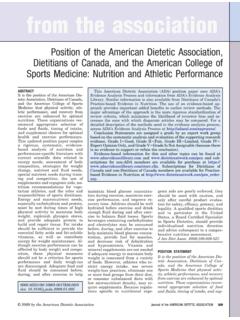Transcription of Evidence Analysis Manual: Steps in the Academy Evidence ...
1 Evidence Analysis manual : Steps in the Academy Evidence Analysis Process Academy of Nutrition and Dietetics Evidence Analysis Library April 2016 ii Evidence Analysis manual : Steps in the Academy Evidence Analysis Process ISBN: 978-0-88091-429-1 Research, International and Strategic Business Development Team Academy of Nutrition and Dietetics 120 South Riverside Plaza Suite 2000 Chicago, IL 60606-6995 800/877-1600 Updated April 2016 Copyright 2016, Academy of Nutrition and Dietetics. All rights reserved.
2 No part of this publication may be reproduced, stored in a retrieval system, or transmitted in any form or by any means without the prior written consent of the publisher. Printed in the United States of America. The views expressed in this publication do not necessarily reflect policies and/or official positions of the Academy of Nutrition and Dietetics. Mention of product names in this publication does not constitute endorsement by the authors or the Academy of Nutrition and Dietetics. The Academy of Nutrition and Dietetics disclaims responsibility for the application of the information contained herein.
3 Table of Contents Preface and Overview 5 Steps in the Evidence Analysis Process 6 Step 1: Formulate the Evidence Analysis Question Why Ask Questions 7 The Nutrition Care Process: A Foundation for Evidence Analysis 10 Identify Key Factors in the Nutrition Care Process 12 Consider Linkages Among Factors 16 Formulate Questions: The pico Format 19 Step 2: Gather and Classify the Evidence Finding the Most Appropriate Research 22 Identify Research that is Relevant to the Evidence Analysis Question 23 Document the search Strategy 24 Classify the Articles by Type of Research Design 30 Step 3.
4 Critically Appraise Each Article Instructions for Abstracting Key Information 40 Abstracting Key Information from the Research Article into the Evidence Worksheet 42 Abstracting Key Information from the Research Article into the Data Extraction Template (DET) 45 Complete the Quality Criteria Checklist (Risk of Bias Tool) and Determine a Rating 49 Display all Checklists Relevant to a Particular Question in a Single Table 59 Step 4: Summarize the Evidence Create Tables and Write the Evidence Summary 62 Create Tables 62 Write a Brief Statement of the Relevant Findings of Each Study 65 Write the Evidence Summary 66 Step 5: Write and Grade the Conclusion Statement How Strong is the Evidence 67 Prepare the Evidence for the Expert Panel to Review 69 Grade the Strength of the Evidence Supporting the Conclusion Statement 70 The Final Step 73 Appendix 1: Question Formulation Template 77 Appendix 2: The pico Format 79 Appendix 3: search Plan & Results Template 80 Appendix 4.
5 Hierarchy ad Classification of Studies 82 Appendix 5: Algorithm for Classifying Research Design 83 Appendix 6: Glossary of Terms Related to Research Design 85 Appendix 7: Evidence Abstract Worksheet Template 89 Appendix 8: Quality Criteria Checklist: Primary Research 91 Appendix 9: Quality Criteria Checklist: Primary Research Non-Human 94 Appendix 10: Quality Criteria Checklist: Review Articles 97 4 Appendix 11: Important Considerations from Checklist by Study Design 98 Appendix 12: Tally Sheet of Quality Criteria Ratings 100 Appendix 13: Sample Tally Sheet from the EAL 101 Appendix 14: Overview Table Template (Worksheet) 102 Appendix 15: Example of an Academy Overview Table from the EAL 103 Appendix 16: Conclusion Statement and Grade 104 Appendix 17: Grade Definitions: Strength of the Evidence for a Conclusion / Recommendation 105 Appendix 18: Conclusion Grading Table 106 Preface How to Use This manual .
6 He Evidence Analysis manual was created by the Academy of Nutrition and Dietetics ( Academy ) to help the systematic review project team - expert workgroup members, project manager, lead analysts, and Evidence analysts understand and carry out the process of Evidence Analysis . Evidence Analysis is a complex process. This manual breaks the process down into concrete parts. A distinction is made between the general Steps of a project, and the more concrete actions within each step. Overview of the manual The manual is divided into two sections main text and appendices: Main text: contains a description of each step along with examples from Evidence Analysis projects.
7 These examples will help you see how the process was carried out successfully. Appendices: contains templates of forms used in an online web-based format. Table i on the following page presents the 5 major Steps in the Evidence Analysis process. Each chapter in this manual corresponds to a step in this process and lists the tools used to accomplish them. They are explained in detail throughout the manual . This manual is available in PDF format from the EAL ( ) Methodology section. T 6 Table i. Steps of the Evidence Analysis Process Steps of the Evidence Analysis Process Brief Description Tools Chapter 1 Step 1 - Formulate Evidence Analysis Question Specify a focused question in a defined area of practice Three key items are used to generate good quality questions: an analytical framework to identify links between factors and outcomes; the pico format to write questions; and the Nutrition Care Process to serve as a framework.
8 Appendix 1: Question Formulation Template Appendix 2: The pico Chart Chapter 2 Step 2 - Gather and Classify Evidence Develop a search plan to conduct a detailed literature search . The search plan should clearly define the inclusion and exclusion criteria and identify the key search terms and outcomes necessary to conduct a comprehensive search . The search plan and all literature searches results are documented and assessed for inclusion eligibility. (Classes are: A, B, C, D, M, R, and X.) Appendix 3: search Plan & Results Table Appendix 4: Classes of Evidence Reports Appendix 5: Algorithm for Classifying Research Design Appendix 6: Glossary of Research Design Terms Chapter 3 Step 3 - Critically Appraise Each Article Critically assess each included article for methodologic quality.
9 Each study is evaluated based on appropriateness of study design and the quality of how the study was conducted by using the Academy 's risk of bias tool called the Quality Criteria Checklist (QCC). Appendix 7: Evidence Abstract Worksheet Template Appendix 8:Quality Criteria Checklist: Primary Research Appendix 9: Checklist: Primary Research Non human Appendix 10: Quality Criteria Checklist: Review Article Appendix 11: Important Considerations (from checklist) by Study Design Appendix 12: Tally of Primary Research Ratings Appendix 13: Tally Sheet Example Chapter 4 Step 4 - Summarize Evidence Key data from the included articles is extracted.
10 Summarize the Evidence extracted from each study into a brief, coherent, and easy-to-read summary. The end result of this phase is called the Evidence Summary. Appendix 14: Overview Table Appendix15: Overview Table Example Chapter 5 Step 5 - Write and Grade the Conclusion Statement Develop a concise conclusion statement for the research question and assign a grade. The grade reflects the overall strength and weakness of Evidence in forming the conclusion statement. (The Academy uses Grades I, II, III, IV, and V for strong, fair, weak, expert opinion only, and no Evidence , respectively.)










